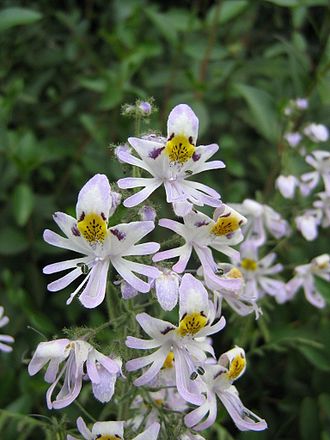Schizanthus

Schizanthus /ˌskɪˈzænθəs/,[1] also called butterfly flower, fringeflower, poor-man’s-orchid, is a genus of plants in the nightshade family, Solanaceae.
They are annual or biennial herbaceous plants, with attractive flowers and they belong to the subfamily Schizanthoideae of the Solanaceae. The genus includes species native to Chile and Argentina, many species are adventitious in other parts of the world such as New Zealand and the United States.[2][3]
Annual or biennial, glandulous-pubescent herbaceous plants, with alternate, pinnatilobate or bipinnatisect leaves and attractive flowers, arranged at the end of stems. The flowers are zygomorphic and hermaphrodite. The calyx has 5 parts, with linear or spatulate segments. The corolla is bilabiate; the superior labia is tripartite, with the central lobe complete and notched and the two laterals bifid. The inferior labia is tripartite with the central lobe notched, almond-shaped and the laterals are complete. The androecium is formed of 4(5) didynamous stamens, the two or three inferior stamens are reduced to staminodes. The fruit is a pluriseminate boll, dehiscent by two bifid valves. The basic chromosome number is x=10.[4]
This is an annual plant that grows up to 40 to 60 cm in height, glandulous and sticky, with divided, irregularly parted leaves of 4 to 8 cm in length, the superior leaves are smaller and often whole. The flowers are divided into a number of segments, they are very colourful, shades of violet with yellow patches and a dark line at the divisions between the upper labia. The flowers are comprised on a short, compact, terminal inflorescence. The fruit is a boll that is shorter than the calyx. This and other species of the genus are cultivated in the United States and in Europe. It originates in Chile where is grows in the littoral zone of the provinces of Coquimbo and Aconcagua. It is called the “butterfly of the coast” (“mariposita de la costa”).[4][5][6] The seeds do not germinate easily in artificial conditions as they need scarification or manual abrasion to obtain good results.[7]
